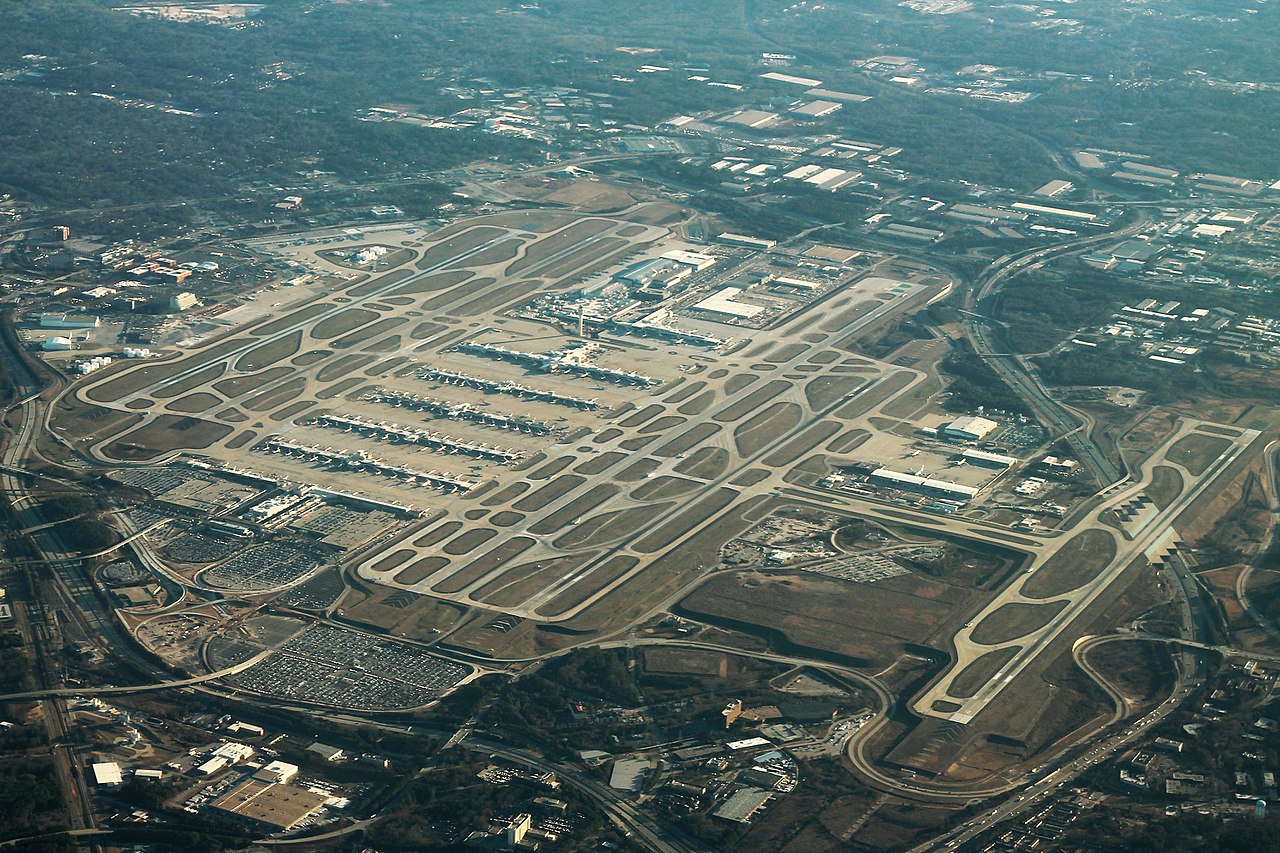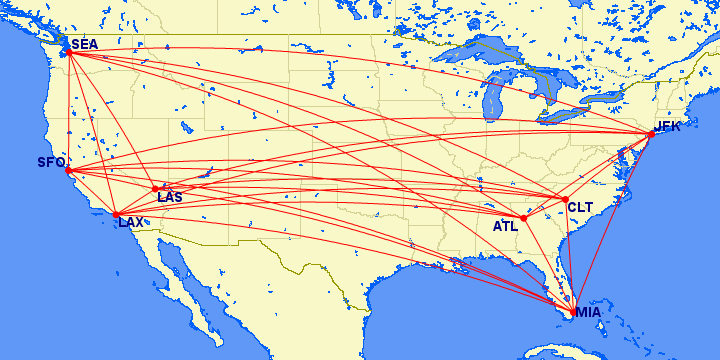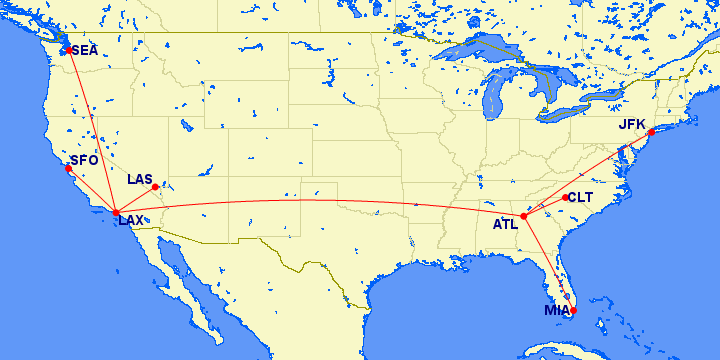This post was written by my sister during the original run of this series on SSC.
I was reading through what bean had posted on commercial aviation earlier, and I ran across a question about why hubs exist. As much as I love my darling brother, I don’t think the answer he gave did justice to the complex, wonderful world of airports. And yes, I am that person who actually enjoys long layovers, and thinks that the airport textbooks bean has given me for my birthday and Christmas are very good gifts. One of the highlights of my summer was sitting in an airport reading an airport management textbook. It was glorious.1

Hartsfield–Jackson Atlanta International Airport, famous as a hub for Delta
Airlines are famously a “pray really hard, cross your fingers, and hope you’ll make enough money to buy a new plane or retrofit old ones” industry. The International Air Transport Association (IATA) is expecting airlines across the world to have a near record total net profit of $29.8 billion, with a profit margin of 4.1% in 2017. The $29.8 billion number might sound really great, but that’s the net profit of all of IATA’s 278 member airlines. This works out to about $107 million per airline, which is enough to buy 89.7% of a Boeing 737 MAX9 (list price of $119.2 million as of May 2017). Granted, some of the IATA airlines made more, some made less, and some lost money, but we’ll use averages for simplicity’s sake. It’s important to remember that most airlines don’t pay full price for their planes, 2 and the purchase of planes is generally funded by either sale of stock or large loans. Hubs save airlines a lot of money. I’ll leave an in-depth explanation of the costs of a commercial flight to someone else (ahem, bean),3 but, in essence, airlines only make money when their planes are in the air, and a plane costs roughly the same to fly whether it’s full or not, because the weight of an additional passenger and their baggage is a drop in the bucket compared to the empty weight of the plane itself. So, airlines make the most money off of full flights, and bleed money on the flights where half the seats are empty. Airlines have a very good incentive to run flights as full as possible. Even though I might want to travel from, say, Lawton, Oklahoma to Lewiston, Idaho, there will never be a direct flight from Lawton to Lewiston because there isn’t enough demand (or really any demand at all- let’s be honest, there’s not much in Lawton,4 and there’s not much in Lewiston5). This is where hubs come in.

The initial route map for Bean Airways, without hubs
For the sake of argument, let’s pretend that there’s only eight airports in the US, four on the east coast, say Atlanta (ATL), New York (JFK), Charlotte (CLT), and Miami (MIA), and four on the west coast, in this case Los Angeles (LAX), San Francisco (SFO), Las Vegas (LAS), and Seattle (SEA). For the record, the FAA lists 514 commercial service airports in the US, which means, in reality, this is significantly more difficult. Suppose our pretend airline, Bean Airways, wants to be able to connect anyone from one airport to any of the other airports. If Bean Airways ran a flight from each of the airports to each of the other airports, there would be 56 flights. If, on the other hand, Bean Airways picked one airport on each coast to be a hub, there would be far fewer flights. Let’s use ATL and LAX for this example. You’d have a flight to and from Atlanta for each of the airports on the east coast, and to and from Los Angeles for each of the airports on the west coast, and a flight between Los Angeles and Atlanta. This is a total of 14 flights to cover the same service area. The two transcontinental flights (one eastbound, one westbound) would be what’s known as a trunk routes, or very profitable, high-demand routes. By having one transcontinental flight it each direction, the flight would become a trunk route for Bean Airways, and Bean Airways would have a significantly higher profit margin and much fuller flights than if it tried to run 24 transcontinental flights by having a direct route between every airport. 678

The route map for Bean Airways with hubs
Legacy carriers really like hubs, and the related hub and spoke transportation model, which is what was described in the Bean Airways example. Airbus tried to capitalize on this when they developed the A380, which allows for the movement of a lot of people at once on ultra-high demand trunk routes. The other model is point-to-point, which is used by low cost carriers, and was the transportation model Boeing had in mind when it developed the 787, a smaller wide-body jet with an ultra-long range that is perfect for long, low demand routes. Allegiant is a prime example of this, as they don’t allow connections, and basically just let people to go from point A to point B. Southwest is a mix of hub and spoke and point to point. They have some airports they use more than others in instances where people need to change planes (Chicago Midway, Baltimore, Las Vegas, Denver, Phoenix, Orlando, Love Field, Houston Hobby, Oakland) that could be considered “hubs”, but, in general, if there’s enough demand to justify a flight between two cities, Southwest will be very quick to open a route, because direct routes are always cheaper for an airline than connections, assuming the demand exists to justify a direct route. I’ll address why in another post, assuming my dear, sweet brother lets me write anything for him again. Thanks for letting me take over for a bit, bean!
1 bean: Yes, this is all true. She really is almost as geeky as I am, just about different things. ⇑
2 bean: Industry rule of thumb is that airlines pay about 50% of list. ⇑
3 bean: Hey, you’re the one with the accounting minor ⇑
4 bean: Yes, there is. A really good artillery museum. ⇑
5 bean: This is more true. ⇑
6 bean: This isn’t quite right, because it would require two stops unless you’re originating or destination in ATL or LAX. In practice, you’d probably set it up so that you’d have one flight from each city to each hub, which still means we drop from 24 transcons to 8. Maybe less, theoretically as low as 4 if we just have one hub for transcons. Passengers dislike making multiple connections. To put more real-world numbers on this, by the late 80s, it was possible to fly between 48,860 pairs of cities in the US with one stop (ref Hard Landing by Thomas Petzinger Jr.) This was great for the 22 people a day who flew between Norfolk and Kansas City. Lawton to Lewiston today still requires a double connection. ⇑
7 I, bean’s favorite sister, would like to take a moment to point out that not all passengers dislike multiple connections. Specifically, I don’t dislike multiple connections. More airports to explore that way. Also, my example is still a very viable way to explain the necessity of hubs. Since you’d be the CEO of Bean Airways (as scary as that sounds), you can run as many flights as you’d like, despite whatever I think. ⇑
8 bean: Yes, but since the extinction of the mileage runner, you’re the only one who likes multiple connections, and you don’t spend enough for the airlines to care. ⇑

Comments
And to think I had a hand in turning you two loose on the planet. I hope your readership can forgive me.
So with online flight search tools, it's becoming possible to schedule multiple-airline trips. To the extent this works, the separate airline networks end up joined into one from the customer's perspective.
In my experience this is still pretty much never the optimal way to schedule flights, but it seems like something that will only increase over time.
Do you think this will change how airlines think about their networks?
Yes and no, but more no than yes. The big airlines are going to view this as a threat. They want to get all of your money, not just part of it. So they have no incentive to make it easy for you to do this. This is neglecting a whole bunch of stuff, like codeshares and joint ventures, but I’m assuming you’re not just booking a trip split on different metal but with one ticket
The yes comes from smaller airlines, who might see this as a chance to cannibalize someone else’s business. The major airlines tend to run banks to try to minimize connection times, and dropping people at a hub just before a bank might let them steal traffic on high-traffic routes. (Frontier flies Denver-Dallas just before an American bank, and the passengers then hop on American planes for their final leg, for instance.) The problem is that without integration, that’s a dangerous game. If the first flight is delayed, they’ll leave without you, and not try to reaccommodate you. Baggage won’t be checked through, and airlines often charge higher prices for flights directly from a hub than flights through a hub because they basically have a captive market. Overall, it just doesn’t seem worth it.
Good discussion and I like that it gives credit to the roles that the A380 and the 787 play instead of painting it as an either/or scenario.
Apart from profitability issues for the 380, I have never viewed Boeing's approach with the 787 as being right or wrong compared to that of Airbus with their "Super." There is room for both. Tons of passengers moving each day from London to JFK for an A380 with the 787 for the fewer that are going from Newark to Osaka or Sapporo (Assuming these city pairs are offered).
While we probably never going to see non-stop service between Lawton (or even Altus, OK just a few miles west!) and Lewiston, it is nice that you can now check your bags in Lawton, have your ticket on your phone, and pick your bags up upon arrival with any stop in between pretty much a no-brainer. Sure that was the way it was supposed to work in yesteryear but it did not always work out so easily.
While that might not seem like much, it is a great benefit for the passenger going from Lawton to Tashkent. This was an advantage that the formal alliances brought--starting with the Star Alliance in the mid 90's and followed quickly by OneWorld and SkyTeam.
With the airlines in an alliance, you can indeed check your bags in Lawton and get a pretty seamless experience all the way to Tashkent or Nairobi or wherever. Should you have club privileges, you can use the airline lounges and a good number of other services--it is almost one-stop shopping. It is certainly easier for the international passenger.
This sunk in to me one day in the late '90s when I was talking with a couple from Cheyenne that was going through Denver to Chicago, to Frankfurt with United, and then on to some place like Ulan Bator with Lufthansa. Long way around but that is what worked (this was before LH started non-stop from Frankfurt to Denver). All one ticket sleeve, baggage claim checks, and other documentation. It really opened up travel options for the public.
Anyway, glad to read someone who did not immediately pit Boeing versus Airbus. Now as for the A350 and the 777-300 that is a different story!
@Neal
But there is much less room for a jumbo because there is only so much trunk routes while the new point-to-point routes are being opened all the time. And those point-to-point routes are eating out the share of the passengers that are travelling on the trunk routes and through hubs. So although the planes can't be compared directly, the business models they are employed in are, in fact, rivals. In fact, Airbuses' own 321LR is, in a way, cannibalizing the jumbo market as well.
@bean & sister bean
Excellent writedown, thank you. Will you be continuing this series? I'm particularly interested in the economics of human resource management for airlines. In short, as more routes become point-to-point, more pilots are needed (and these pilots need to be experienced, they fly long hours, and thus, need to be paid well). Where will all those pilots come from? I stumbled on this video (https://www.youtube.com/watch?v=cognzTud3Wg), does it adequately represent the situation, in your opinion?
@Inky
I'm sort of with you on 787 vs A380. They were two very different bets on the market, and Boeing seems to have won a decisive victory.
This series has one more post from the original run, and Neal has graciously provided two more parts past that. I'm probably going to write one more as well.
The pilot shortage is probably going to resolve itself, but it will take a few years. The big issue is that we've spent the last 10 or so with a major bottleneck, where anyone entering the field was going to spend a long time, possibly their whole career, as a pilot at one of the regionals, which is the aviation equivalent of an adjunct professorship. These days, demand is high enough that the regionals are paying decently well and the majors are hiring again. I think it will work out once that trickles down to the flight schools and such.
@Inky
Point well made regarding the A380 and the cannibalization of the long-haul markets--now by aircraft even at the A321LR level. Spot on with the observation that this was much more than just one aircraft type set against another, but rather rival business visions. I have to admit that the long-haul market scattered out, and then some, quicker and wider than I had ever expected. To Boeing goes credit for how it saw this playing out.
It is this type of discussion that I enjoy though, for all too often partisans of one manufacturer or another want to fight their corner based on the aircraft itself rather than the economics behind its development and fielding.
That being said, I still harbor a like for the idea of the 380 in high-demand markets. Although I know that the program is now in doubt, I still wish, however unrealistically, that it could somehow made to prosper.
I am just glad that no one took me to task for my remarks advocating some benefits of the airline alliances. Often such comments are met with a cry of "cross-border oligopolies" or worse!
@Neal
A380 is a marvel of engineering, no doubt about that, but Airbus will increasingly strive to maintain the program afloat. With few new orders coming up and still having to keep facilities open to service existing planes which will be around for 10 to 20 or even more years it's a massive drain on resources. All while the 777X is preparing to go into production, which will be more fuel effective, cheaper (not by a large margin though) and will likely to share type ratings with existing 777s. And hypothetical 777-10 will be playing in the same ballpark, capacity-wise. All things considered, times are not looking good for the jumbo.
@bean
Won't the projected increases in pay cripple low-cost airlines? Their whole business model angles on being able to cut corners wherever possible, including crew compensation.
Low-cost carriers and regional airlines are different things. The regionals fly the 76-seat jets for the major airliners, and are the ones who traditionally have terrible pay. LCCs fly full-size narrowbodies and I'm not sure what their pay scales are like. I'd guess that they save their money by keeping their payscales flatter than the majors. You'll make more money on the front end, but be trailing after 5 years or so. But Neal might know more on that than I do.